

 (ማስታወቂያ)
(ማስታወቂያ)
Discover the unique and stunning birdlife of Ethiopia with our guide to 20 of the most spectacular and loved endemic birds. From the vibrant Abyssinian roller to the elusive Harwood's francolin, each of these birds is a fascinating example of Ethiopia's incredible avian diversity. If you're interested in exploring even more of Ethiopia's endemic wildlife, be sure to check out our article on endemic Ethiopian animals. There, you'll discover the amazing creatures, excluding birds, that call Ethiopia home, from the agile Walia ibex to the quirky Ethiopian hare. Whether you're a birder looking to add new species to your life list or a nature lover looking to explore the captivating wildlife of Ethiopia, this article has something for you. So join us on a journey through the skies of Ethiopia and discover the beauty of its unique and stunning birdlife! And don't forget to check out our article on endemic Ethiopian animals for even more incredible creatures to discover.
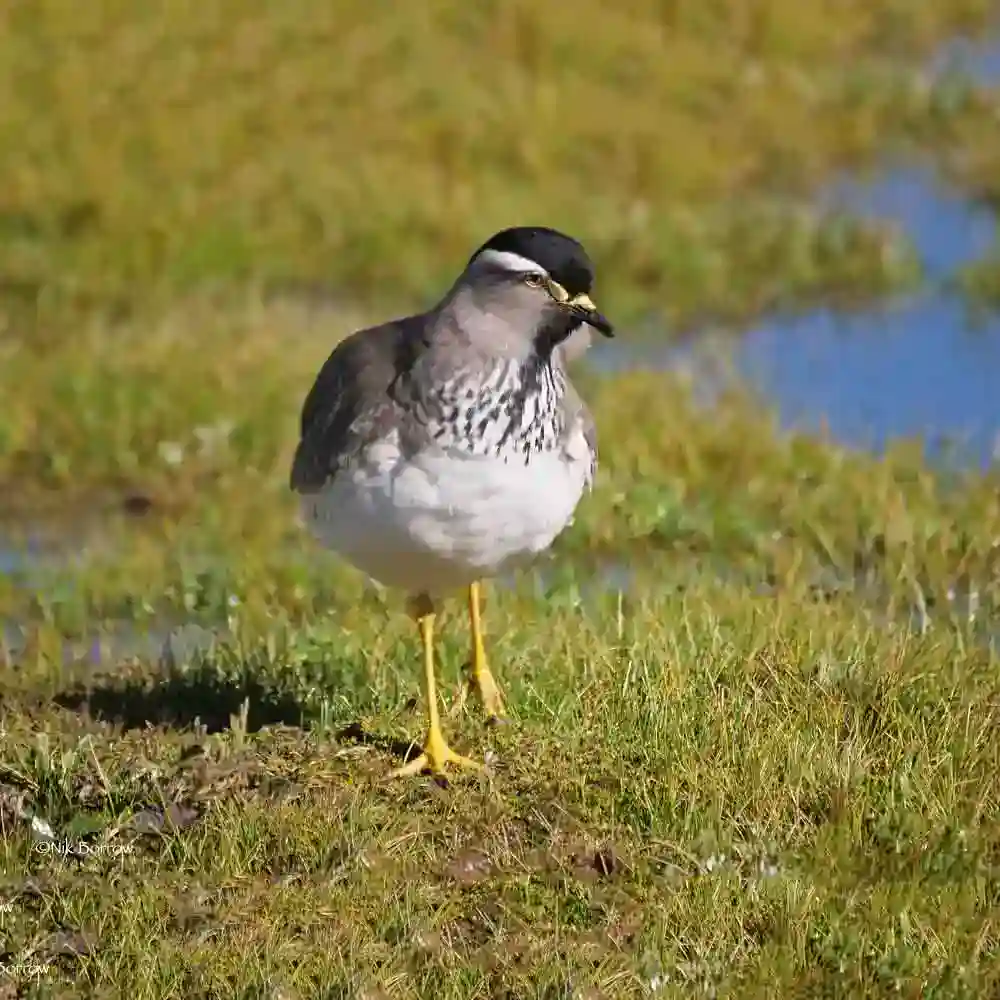
• Scientific name: Vanellus melanocephalus The Spot-breasted Lapwing is a chunky lapwing commonly found in the Ethiopian highlands. The bird is characterized by its black cap, white eyebrow, black throat, and black spots across its neck and breast. It is found in both wet and dry montane habitats, including grassland, moorland, and marsh. The Spot-breasted Lapwing is often seen in flocks, which can be quite large ranging from 30 to 40. In flight, the bird looks similar to other lapwings, but can be easily distinguished by its distinctive head and breast pattern. The bird's call is a rough "shrek," which is often repeated. The Spot-breasted Lapwing feeds primarily on insects, including grasshoppers, beetles, and ants, and is known to forage on the ground. The bird is also known for its elaborate courtship display during the breeding season, which involves the male running in circles around the female. Although the Spot-breasted Lapwing is not currently considered to be at risk of extinction, its natural habitat is threatened by agricultural development and other human activities. Conservation efforts are underway to protect the bird's habitat and ensure its continued survival.
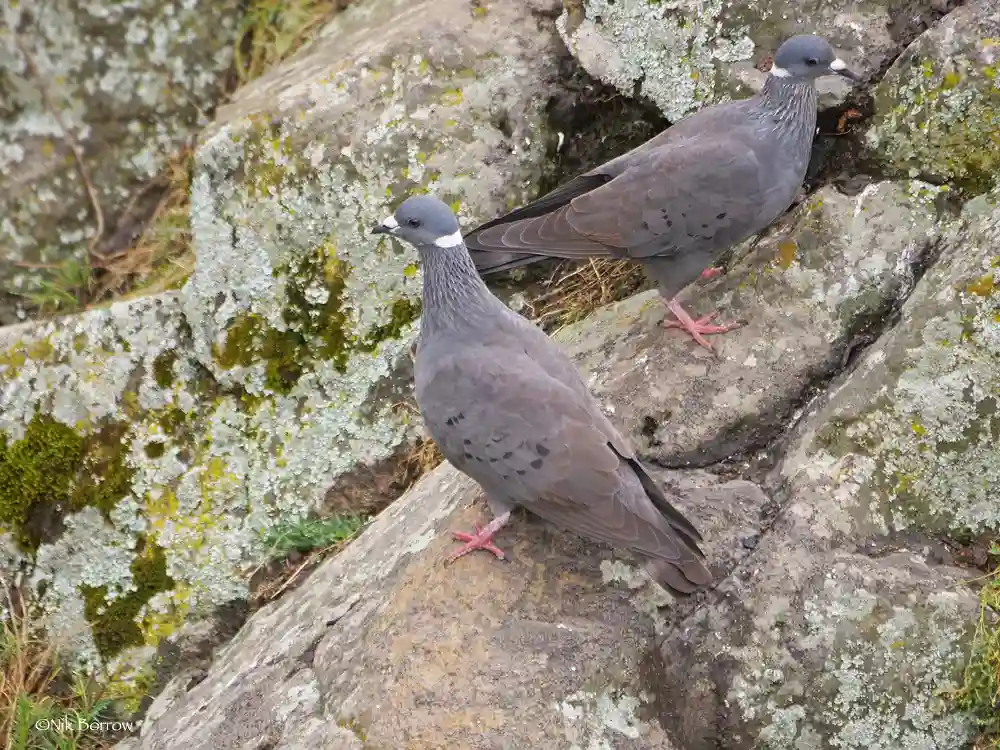
• Scientific name: Columba albitorques The White-collared Pigeon is a species of bird in the family Columbidae. Endemic to the Ethiopian highlands in Eritrea and Ethiopia, this bird is commonly found in the countryside surrounding rocky cliffs and gorges, as well as in town centers. The White-collared Pigeon is monotypic, meaning no subspecies are recognized. The bird measures around 32 cm (13 in) in length and is characterized by its large grey-brown body and slate-grey head, which contrasts with a conspicuous white hind-collar. In flight, the bird shows prominent white wing patches formed by white inner primary coverts. The White-collared Pigeon primarily feeds on fruits and seeds and is known to forage in the tree canopy. The bird is often seen in pairs or small flocks and its flight is characterized by rapid wingbeats and occasional glides. The White-collared Pigeon builds a simple nest of twigs and leaves in the branches of a tree during the breeding season. The female lays one or two eggs, which hatch after around two weeks. The young pigeons are cared for by both parents and fledge after around three weeks. Although the White-collared Pigeon is not currently considered to be at risk of extinction, its natural habitat is threatened by deforestation and other human activities. Conservation efforts are underway to protect the bird's habitat and ensure its continued survival. Fun fact: The White-collared Pigeon's prominent white hind collar is a distinctive feature that helps to identify this beautiful bird.
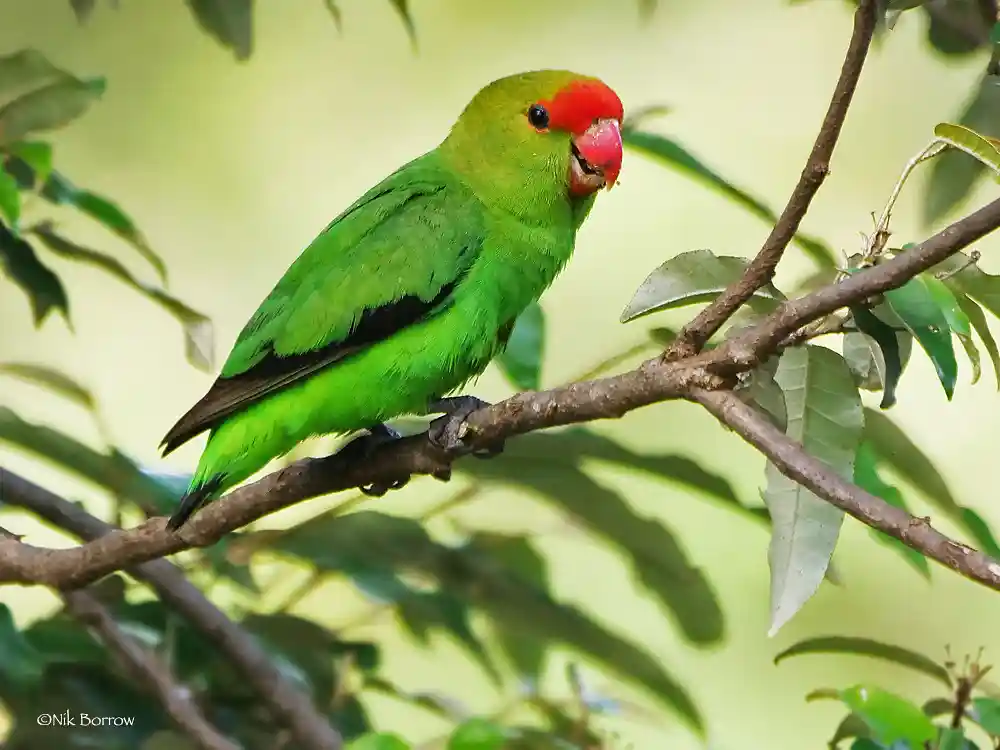
• Scientific name: Agapornis taranta The Black-winged Lovebird, also known as the Abyssinian Lovebird, is a beautiful parrot that is mainly green in color. It is the largest of the lovebird genus, measuring about 16.5 cm (6.5 inches) in length. The adult male is easily identified by its red forehead and ring of red feathers around its eyes, while the adult female has an all-green head. The Black-winged Lovebird is native to Eritrea and Ethiopia and is uncommon as a pet. In the wild, these birds live in high plains or mountainous regions. Their diet consists of sunflower seeds, corn, apples, and mission figs. These birds nest in tree cavities and typically lay three or four white eggs in a clutch. The female incubates the eggs for 23 days, and the chicks fledge from the nest about 45 days after hatching. The Black-winged Lovebird is a common and widespread species throughout its habitat range and is evaluated as Least Concern on the IUCN Red List of Threatened Species. However, it has not become well-established in aviculture, and breeding in captivity is on a small scale. Fun fact: The holotype of the Black-winged Lovebird was collected in Taranta Pass, Acchele Guzai District, Eritrea, in 1809-10 by Henry Salt. The specimen is held in the vertebrate zoology collection of National Museums Liverpool at World Museum.
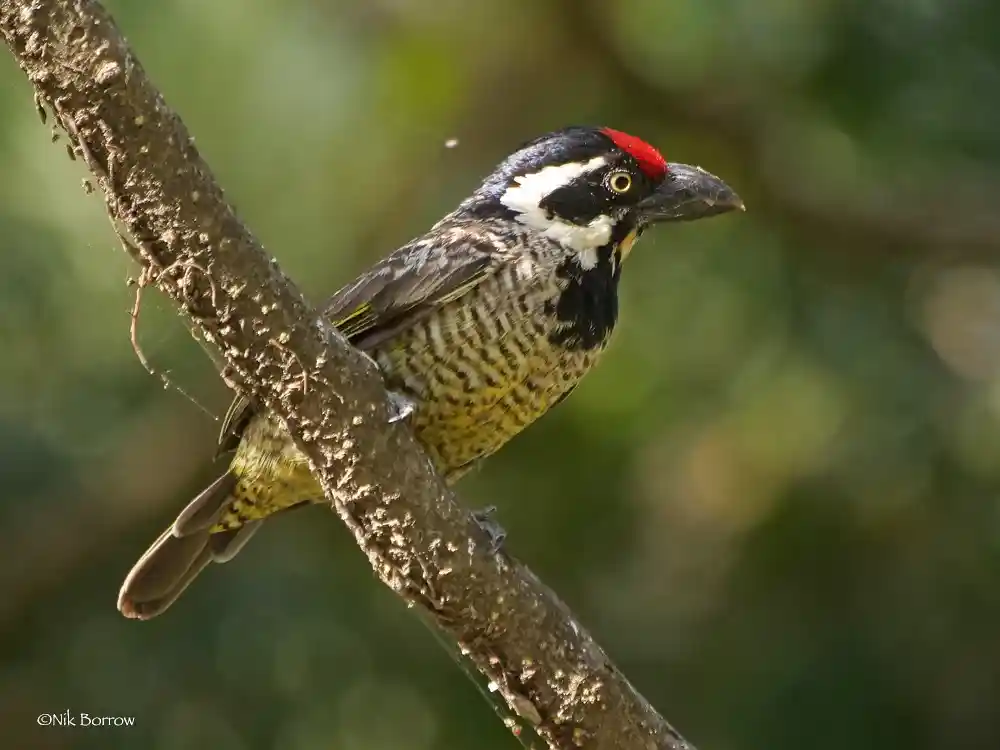
• Scientific name: Lybius undatus The Banded Barbet, also known by its scientific name Lybius undatus, is a species of bird that belongs to the family Lybiidae. It is found in Eritrea and Ethiopia and is somewhat of a mystery bird, as its numbers and abundance have not been determined. However, it is widely distributed throughout Ethiopia between 300 and 2400 metres (1000–8000 feet), and seems to vary from being uncommon in the north-west and cast to locally common elsewhere in the country. This bird is approximately 20-25 cm long, with a stocky build, a large head, and a heavy bill with bristles. The Banded Barbet feeds on insects, such as beetles, and the fruit of fig trees. It has also been observed hawking insects like a flycatcher and hanging from a branch upside down like a tit. The bird's call notes are metallic and it produces a "gr-gr-grgrgr..." in rising tempo. The Banded Barbet nests in a hole in a branch of a tree or in a tree stump. The female lays approximately two to four eggs, which both parents share the parental nesting responsibilities for. The eggs incubate for 13-15 days. Taxonomically, the Banded Barbet is somewhat of a mystery bird that has been placed in the genus Lybius for now. It could represent an evolutionary link between the sister genera Tricholaema and Lybius. Fun fact: The Banded Barbet's heavy bill with bristles is an adaptation that helps the bird to feed on fruit and insects more effectively.
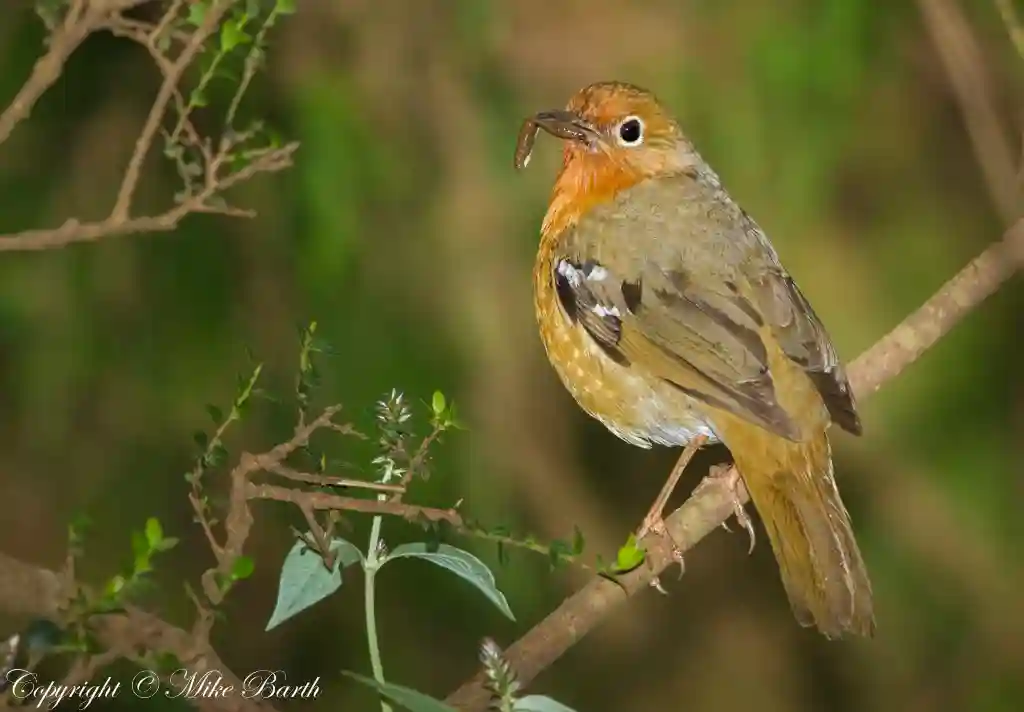
• Scientific name: Geokichla piaggiae The Abyssinian Ground Thrush, also known by its scientific name Geokichla piaggiae, is a shy and solitary bird belonging to the thrush family Turdidae. It is native to high altitude montane forests in northeast Africa, and can be found in six different subspecies across Sudan, Ethiopia, the Democratic Republic of Congo, Kenya, Uganda, Rwanda, and Burundi. The Abyssinian Ground Thrush is an attractive bird, with deep rufous-orange coloring on its head and face, and a distinct white eye ring. Its upperparts are olive brown, and it has two prominent white wingbars on the folded wing. The bird measures around 19-20 cm in length and weighs 43-65g. This bird is typically found in the undergrowth of evergreen montane forests, between 1,800 and 3,300 m in high rainfall regions, mostly above 2,500m. It forages on the ground where it hops, runs, or walks under trees or dense vegetation, and feeds on earthworms, millipedes, snails, insects, and fruits such as figs and berries. It is frequently found near forest streams in moss and lichen-covered areas and may also frequent the edges of clearings or paths. The Abyssinian Ground Thrush breeds during the rainy season, which varies throughout its range. The nest is a cup of moss or other plant material lined with plant fibers, and is usually situated below 5m above the ground in the fork of a branch or sapling, well hidden. The female lays two eggs, and the young are fed by both parents. After fledging, they remain with their parents for up to three months. Taxonomically, the Abyssinian Ground Thrush has been placed in various genera, including Turdus and Zoothera, but is currently placed in the Geokichla. It is somewhat of a mystery bird, and its numbers and abundance have not been determined. However, it is an important part of the ecosystem in the high-altitude montane forests of northeast Africa. Fun fact: The Abyssinian Ground Thrush is known for its shy and solitary nature, and will quickly hide in cover if danger threatens.
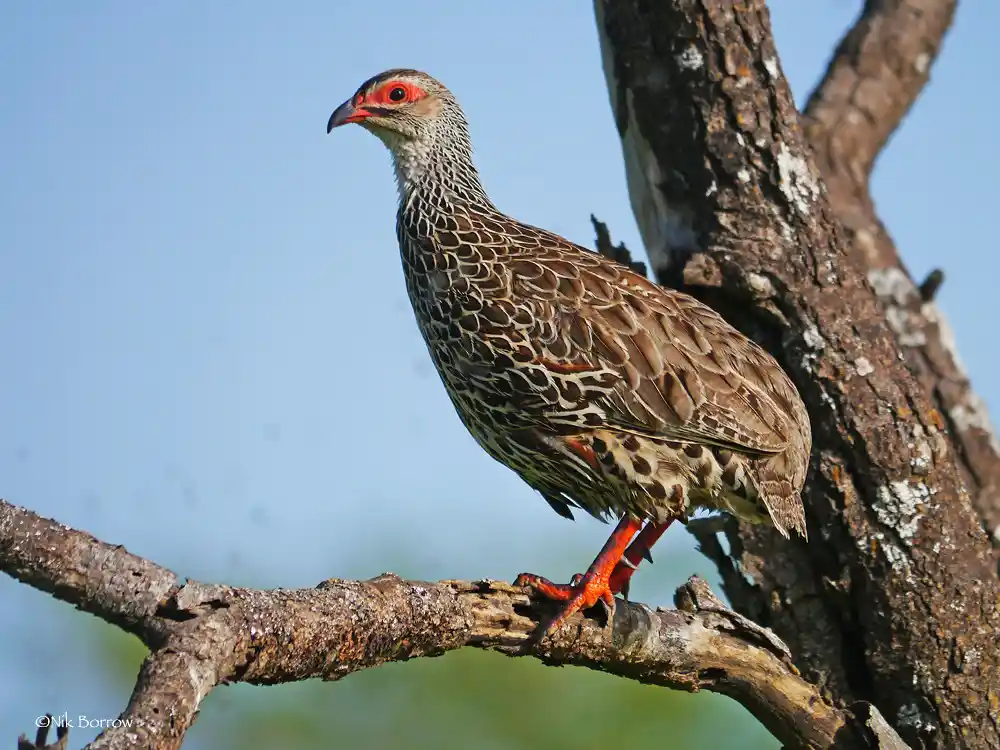
• Scientific name: Pternistis Harwoodi Harwood's Spurfowl, also known as Harwood's Francolin, is a species of bird in the family Phasianidae. It is a grey-brown bird with a red bill, tail, and bare skin around the eyes. Both sexes have similar coloring, although the female is paler in color with a more extensive buff belly. This spurfowl is endemic to Ethiopia, with a range restricted to the Ethiopian highlands on either side of the Blue Nile River between Lake Tana and its confluence with the Jamma River, as well as its tributaries between these points. Originally, it was thought to inhabit Typha beds growing along small, shallow watercourses and acacia thickets, but studies in 1996 found Harwood's Spurfowl in a site with neither of these. The bird is threatened by habitat loss due to population pressures, which force locals into the marginal scrublands favored by the bird as its habitat. Additionally, Harwood's Spurfowl is heavily hunted for food and is sometimes caught for sale at local markets, while its eggs are also a food source. Taxonomically, Harwood's Spurfowl was first described in 1899 by the English ornithologists Herbert Weld Blundell and Simon Fraser, 14th Lord Lovat, from a specimen collected in the Aheafeg area of Ethiopia. They coined the binomial name Francolinus harwoodi in honor of the taxidermist and naturalist Leonard Harwood. The species is now placed in the genus Pternistis, which was introduced by the German naturalist Johann Georg Wagler in 1832. Recent molecular phylogenetic studies have found that Harwood's Spurfowl is closely related to Clapperton's Spurfowl, and the species is considered to be monotypic, with no recognized subspecies. Fun fact: Harwood's Spurfowl is a shy and elusive bird that is rarely seen in the wild, making it a challenging sighting for birdwatchers and ornithologists.
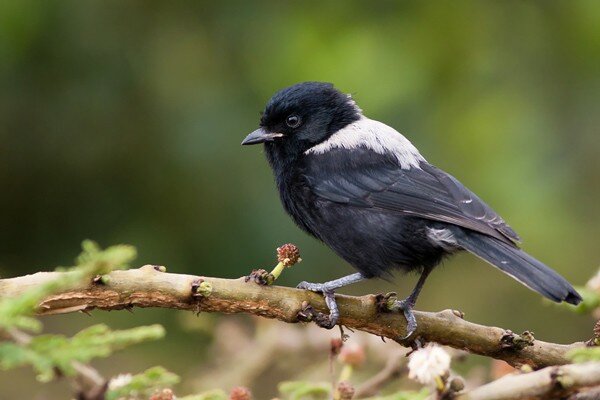
Image source: africanbirdclub.org • Scientific name: Parus leuconotus The White-backed Black Tit, also known as the White-backed Tit, is a small bird in the family Paridae and is found in Eritrea and Ethiopia. Its natural habitat is boreal forests, and it is most commonly found between 1,800m and 3,200m in Juniperus, Hagenia, and Arundinaria (highland bamboo) woodland. The bird is mostly black with a pale back and males have a bright white back while females and immatures have a buff-colored one. The White-backed Black Tit is a sociable bird that usually occurs in pairs or small family parties and is often found in mixed flocks. It forages on trunks, branches, and twigs, often acrobatically searching for invertebrates among lichens and mosses in its preferred habitats. The bird exhibits an impressive range of calls and song motifs, some of which are reminiscent of sparrow or even bulbul species. The White-backed Black Tit is a fairly small bird, measuring around 13.5 cm in length, and is endemic to a variety of forest and wooded habitat types in the Afrotropical Highlands biome of Ethiopia and Eritrea. Despite being a distinctively marked member of the Tit family, little is known about the White-backed Black Tit's breeding behavior, social habits, diet, and movements. The bird's population density is generally low across its range, making it a poorly known species. However, evidence from as far back as 1870 indicates that its population trends are stable, and it has been uncommon within its range ever since its description in 1843. Fun Fact: The White-backed Black Tit was rediscovered in Eritrea in 2008 by JA after a period of over 50 years.
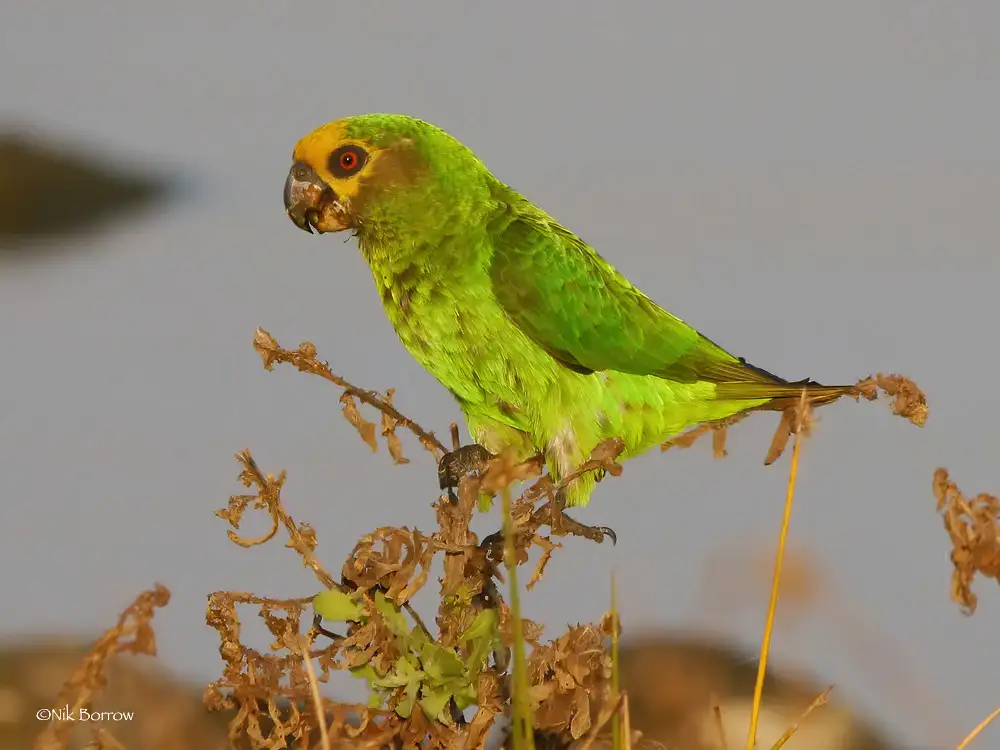
• Scientific name: Poicephalus flavifrons The Yellow-fronted Parrot, also known as the Yellow-faced Parrot, is a parrot endemic to the Ethiopian Highlands. It was first described by German naturalist Eduard Rüppell in 1845. The bird's species name is derived from the Latin words flavus "yellow" and frons "forehead." The Yellow-fronted Parrot is mostly green in color, with the upper parts being a darker green and the tail being olive-brown. The face is orange-yellow, while the upper beak is brownish-grey and the lower beak is bone-colored. The bird's irises are orange-red, and its bare eye-rings and cere are grey. The adult male and female have an identical external appearance, while juveniles are duller than adults with mostly grey heads and brown irises. This bird is approximately 28 centimeters (11 inches) long and is found in the Ethiopian Highlands at about 1,000–3,000 meters (3,300–9,800 feet) above sea level. It lives in forest habitats, unlike most other Poicephalus parrots apart from the Cape and red-fronted parrot superspecies complex. The Yellow-fronted Parrot was unknown in aviculture until recently, but it has since been successfully bred in captivity and can now be found in several European countries. Both subspecies, P. f. flavifrons and P. f. aurantiiceps, are represented. Relatively little is known about this bird, and while most recent authorities treat it as monotypic, some recognize two slightly different subspecies. Conservation efforts are needed to protect the Yellow-fronted Parrot and ensure its continued survival in the wild. Fun fact: The Yellow-fronted Parrot's face and head feathers are yellow or orange-yellow, making it easy to distinguish from other parrots in the region.
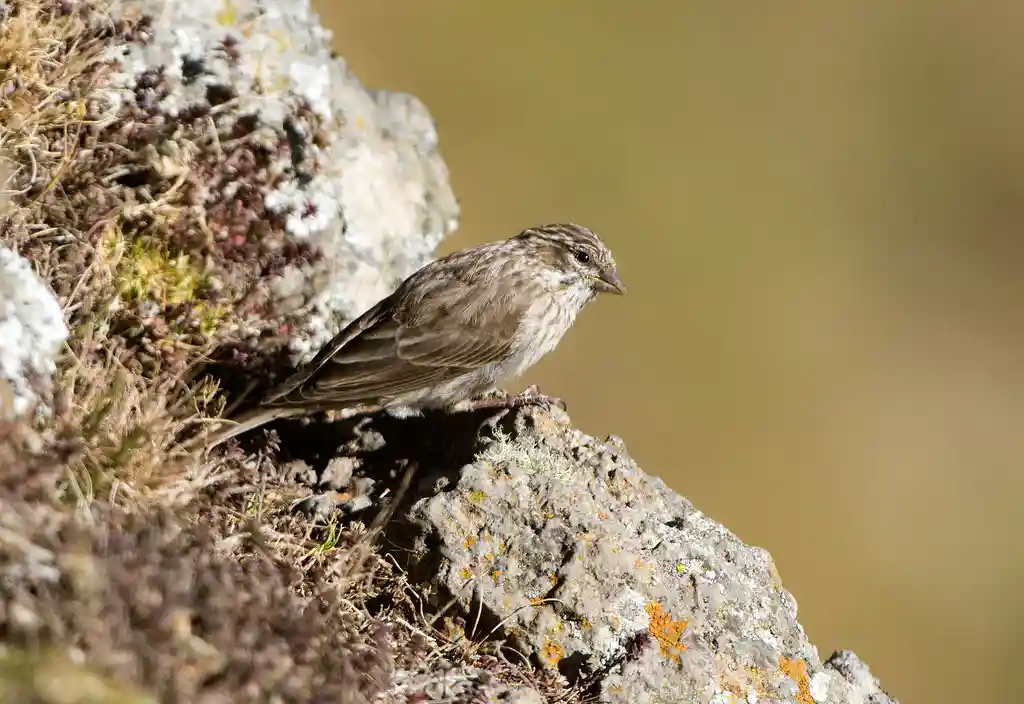
• Scientific name: Serinus ankoberensis The Ankober Serin, also known by its scientific name Crithagra ankoberensis, is a small brown seedeater that belongs to the family Fringillidae. It measures about 12 centimeters or 5 inches in length and is distinguished by heavy buffy-colored streaking on its head and breast. This bird is gregarious and is often encountered in flocks. Its song consists of a constant, low twitter. The Ankober Serin is endemic to Ethiopia, inhabiting steep rocky slopes and high cliff-tops. The reported range of the bird consists of several disjointed areas in northern Shewa and in the northern Amhara Region. However, this species is threatened by habitat loss. The Ankober Serin was formerly placed in the genus Serinus, but phylogenetic analysis using mitochondrial and nuclear DNA sequences found that the genus was polyphyletic. As a result, the genus was split, and a number of species, including the Ankober Serin, were moved to the resurrected genus Crithagra. Conservation efforts are necessary to protect the Ankober Serin and ensure its continued survival in the wild. Habitat conservation and restoration programs could be implemented to address the threats that this species faces. Additionally, more research could be conducted to better understand the ecology and behavior of the Ankober Serin. Fun fact: The Ankober Serin is named after the Ankober region of Ethiopia, where it was first discovered in the 1960s.

• Scientific name: Parophasma galinieri The Abyssinian Catbird, also known as the Juniper Babbler, is a species of bird in the family Sylviidae that is endemic to Ethiopia. It is a fairly small, mostly grey bird with black lores, a whitish forehead, and a chestnut vent. Abyssinian Catbirds measure around 19 cm (7.5 in) in length, with a round body, short wings, and legs, and a short, pointed, black beak. The bird's wings are the darkest parts of its body, with parallel bars of black along its length, while its underside from its legs to its tail is a distinct orange. Abyssinian Catbirds are found in highland forest and scrub habitats in Ethiopia, and are more commonly found at higher elevations around 11,500 feet (3,500 meters), such as in the mountainous northern Semian region or in the hilly western region of the nation. They have a wide-ranging diet that consists mostly of small, edible things, including juniper berries and various insects that are found in their habitat. The Abyssinian Catbird is known for its beautiful singing, and it has been said to be the finest singer of African birds. During the rainy season, male and female Abyssinian Catbirds can be found harmonizing together to make an even more beautiful song. The male makes a loud ringing sound while the female releases a purring sound. Abyssinian Catbirds breed from February to August (or January to July), and their nests, often consisting of a tangle of vines and plant stems, hold two pale-colored, dark-speckled eggs. The bird is evaluated to be of least concern on the IUCN Red List and does not have any reported threats. It is relatively abundant in its general area, despite its apparent decreasing population trend.
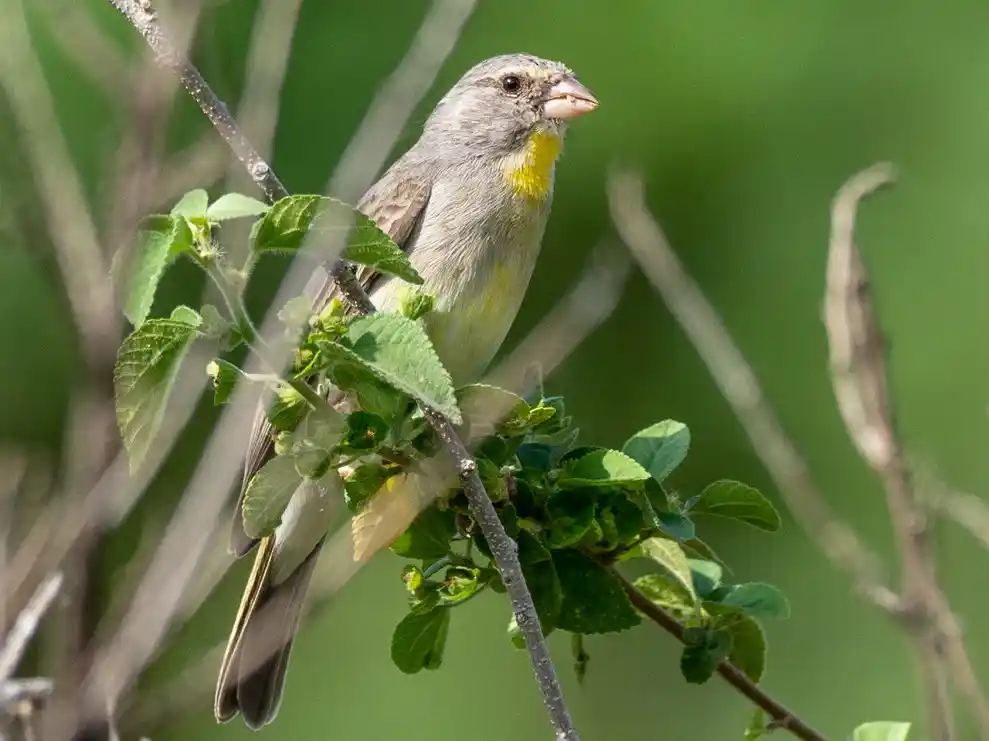
Image source:ebird.org • Scientific name: Serinus flavigula The Yellow-throated Seedeater, also known by its scientific name Crithagra flavigula, is a species of finch that belongs to the family Fringillidae. It is found only in Ethiopia and is primarily found in subtropical or tropical dry shrubland and subtropical or tropical dry lowland grassland habitats. Unfortunately, it is threatened by habitat loss. The bird's voice is a jumbled chirpy song, and its call is canary-like with a distinct zeee-zsreee sound. The Yellow-throated Seedeater prefers semi-desert areas with thick patches of scrub on rocky hill sides and scattered trees in savannah-type areas. It also prefers highlands rather than lowlands. The Yellow-throated Seedeater was formerly placed in the genus Serinus, but phylogenetic analysis using mitochondrial and nuclear DNA sequences found that the genus was polyphyletic. As a result, the genus was split, and a number of species, including the Yellow-throated Seedeater, were moved to the resurrected genus Crithagra. Overall, the Yellow-throated Seedeater is a unique and fascinating bird that is unfortunately threatened by habitat loss. Conservation efforts are needed to protect this species and its habitat and ensure its survival for future generations to enjoy.
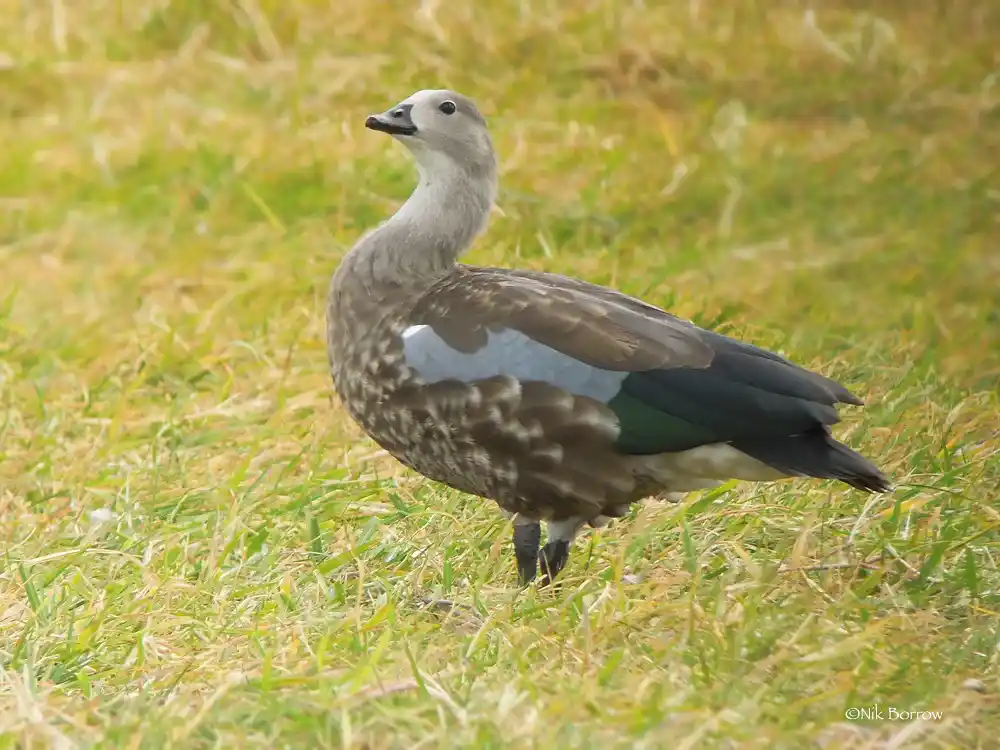
• Scientific name: Cyanochen cyanoptera The Blue-winged Goose, also known by its scientific name Cyanochen cyanoptera, is a waterfowl species that is endemic to Ethiopia. It is the only member of its genus, Cyanochen. The relationships of this species among waterfowl are unresolved, but it appears morphologically close to shelducks, particularly the South American sheldgeese, which have highly similar courtship displays. However, mitochondrial DNA sequence analyses suggest that it might belong to a distinct and ancient "duck" clade, together with Hartlaub's duck, another African species of uncertain affinities. The Blue-winged Goose is a stocky grey-brown bird, about 70 centimetres (28 in) long, with a slightly paler head and upper neck, a small black bill, and black legs. Although it looks fairly dull when standing, in flight, this species shows a pale blue forewing. The plumage of these birds is thick and loose, with a fur-like appearance that is an adaptation to the cold of the Ethiopian highlands. The Blue-winged Goose primarily inhabits rivers, freshwater lakes, swamps, freshwater marshes, water storage areas, and subtropical or tropical high-altitude shrubland or grassland. It feeds by grazing and is apparently largely nocturnal, loafing during the day. It can swim and fly well but is reluctant to do either and is quite approachable. It forms flocks outside the breeding season. The Blue-winged Goose breeds by mountain lakes and streams and is believed to build a lined nest amongst grass tussocks, where it lays 6-7 eggs. This little-known species is threatened by habitat loss, trapping for food, and possibly drought, and is classified as a Near Threatened species on the IUCN Red List. Fun fact: The Blue-winged Goose is a quiet species, but both sexes may give a soft whistle; it does not honk or cackle like true geese.

• Scientific name: Menelikornis ruspolii Ruspoli's Turaco, also known as Prince Ruspoli's Turaco and scientifically named Menelikornis ruspolii, is a species of bird that belongs to the family Musophagidae. It is endemic to southern Ethiopia, where it inhabits subtropical or tropical dry forests. Unfortunately, the bird is threatened by habitat loss. The species was first collected by Eugenio Ruspoli, an Italian explorer, in either 1892 or 1893, although the exact location and date of the discovery remain unknown. The bird was named in Ruspoli's honor by T. Salvadori, who examined the collection after Ruspoli's death. Ruspoli's Turaco is suspected to have a small population, and its numbers are decreasing moderately rapidly due to habitat degradation and hybridization with the White-cheeked Turaco. As a result, the bird is classified as Near Threatened on the IUCN Red List of Threatened Species. The population size is estimated to be between 2,500 and 9,999 individuals. Despite being threatened, Ruspoli's Turaco remains a beautiful and fascinating bird. Its bright green and red plumage, along with its distinctive crest, make it a striking sight in its natural habitat. Conservation efforts are underway to protect the bird's habitat and ensure its continued survival. Fun fact: Turacos are known for their vibrant plumage, which is not the result of pigments, but rather the structure of their feathers that refract light.

• Scientific name: Calandrella erlangeri Erlanger's Lark, also known as Calandrella blanfordi erlangeri, is a small passerine bird endemic to the highlands of Ethiopia. It is considered a subspecies of Blanford's Lark and is named after the German ornithologist Carlo von Erlanger. This relatively small and plain lark displays regional variations in coloration, ranging from dark brown to paler brown to rufous. However, it is characterized by a pale eyebrow and eye-ring, streaking on the breast, and a completely or partially pale bill. Erlanger's Lark is typically found in dry grassland and semi-desert habitats, usually in flocks. To differentiate it from the similar-looking Singing Bushlark, look for its slightly buffy outer tail rather than pure white and the absence of rufous patches in the wings. The bird's flight song is a long and complicated jumble that can include imitations of other species, while its call is a quick "chidup," often given in flight. The bird's breeding season is from March to August, during which it builds a nest on the ground and lays two to three eggs. However, the species is considered vulnerable due to habitat loss caused by agriculture, overgrazing, and mining activities. Conservation efforts are being made to protect its habitat and ensure its survival. Fun fact: Erlanger's Lark is known for its unique display behavior, where it flies up into the air and then descends to the ground with its wings held high, making a buzzing sound with its feathers.

• Scientific name: Hirundo megaensis The White-tailed swallow, also known as Benson's swallow, is a small bird belonging to the family Hirundinidae. It is endemic Ethiopia and is classified as a vulnerable species by the International Union for Conservation of Nature (IUCN). The bird is named after the ornithologist Constatine Walter Benson, who discovered the species. The White-tailed swallow is sexually dimorphic, with males having brighter blue and white plumage than females. The bird's natural habitat is subtropical or tropical high-altitude shrubland, and it is found at altitudes between 4,000-4,500ft. The White-tailed swallow builds its nests in traditional Borana huts and termite mounds. The nests are built of mud, grass, and animal hair and are typically around 60-160mm deep. The bird breeds twice a year and lays 3-4 white eggs per breeding season. The incubation phase lasts between 2-3 weeks. The White-tailed swallow is one of the most threatened bird species by climate change, as it has a small range and is wholly dependent on a cooler "bubble" surrounding its small range for proper breeding success. The bird is threatened by habitat loss caused by bush encroachment due to fire suppression and overgrazing. Humans also contribute to habitat loss through an increase in population, overgrazing, and increased cultivation in the area. The Yabelo wildlife sanctuary is a protected area in which the White-tailed swallow can be found, but there is previously noted fire suppression in the area which contributes to bush encroachment. Traditional Borana huts are essential for conserving the species and providing suitable nesting locations. The White-tailed swallow may serve as an indicator species for climate change, allowing them to test the reliability of habitat models for other threatened animals and may also serve as a flagship species for the impacts of climate change on avian diversity in Africa.
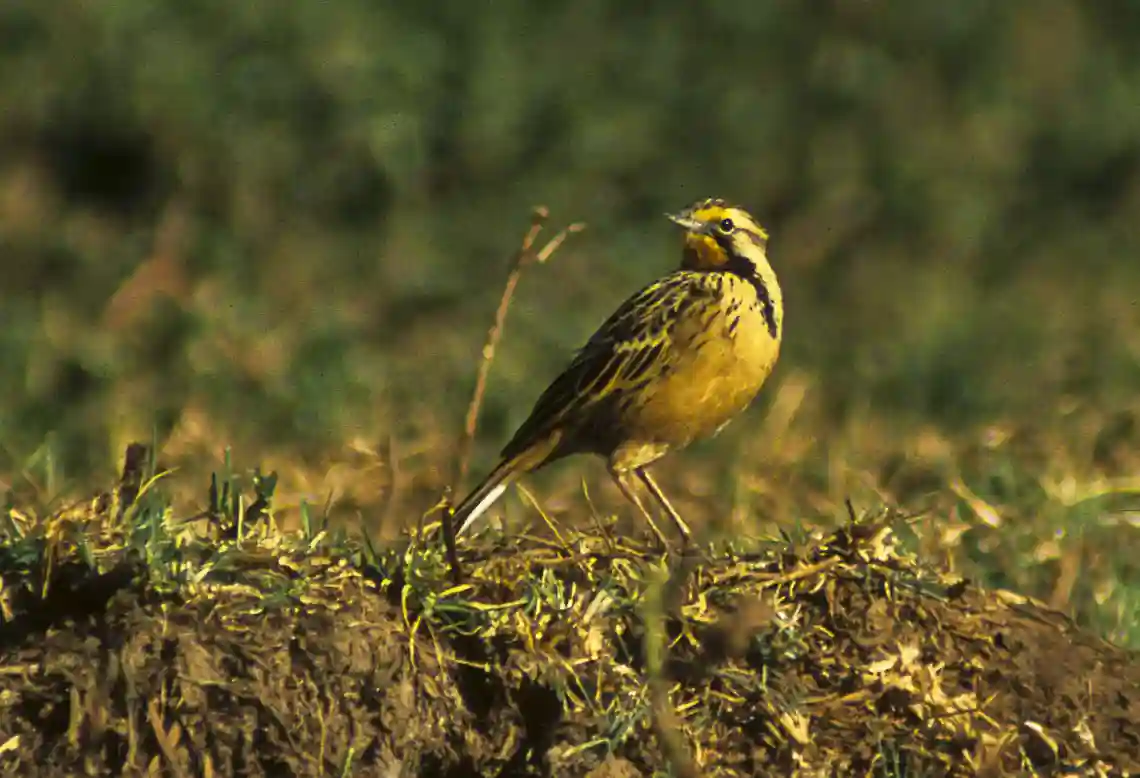
• Scientific name: Macronyx flavicollis The Abyssinian Longclaw, also known by its scientific name Macronyx flavicollis, is a bird species that belongs to the family Motacillidae. It is endemic to Ethiopia, and its natural habitats include subtropical or tropical high-altitude grasslands of the Ethiopian Highlands, as well as arable land. The Abyssinian Longclaw is very similar in both appearance and behavior to the Yellow-throated Longclaw (Macronyx croceus) found in other parts of Africa. The Abyssinian Longclaw is a common grassland bird of the western and southeastern Ethiopian Highlands, except in the extreme north where it does not occur. However, the Abyssinian Longclaw is threatened by habitat loss due to human activities such as land conversion for agriculture, overgrazing, and infrastructure development. These activities have led to the degradation and fragmentation of the bird's natural habitat, putting the species at risk. Conservation efforts are necessary to protect the Abyssinian Longclaw and its habitat. This includes promoting sustainable land use practices, protecting grasslands, and raising awareness about the importance of conserving biodiversity. The Abyssinian Longclaw is an important species for its ecosystem, and its conservation is crucial for maintaining the ecological balance of the Ethiopian Highlands. Fun fact: The Abyssinian Longclaw is known for its distinctive, long, sharp claws, which are adapted for walking and running on grasslands. These claws allow the bird to find and capture insects, which make up a significant part of its diet.
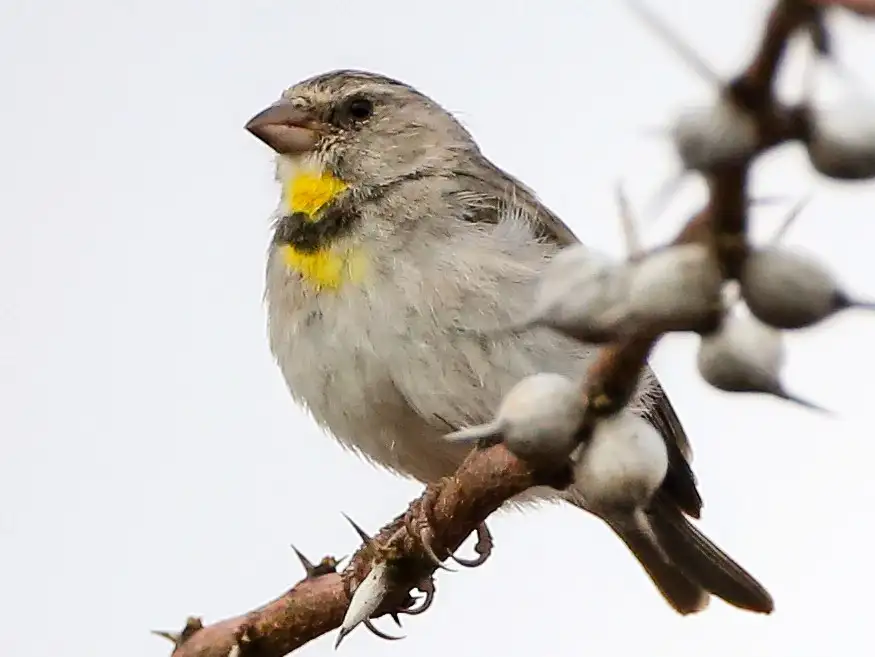
• Scientific name: Crithagra xantholaema Salvadori's Seed-eater, also known as Salvadori's Serin with the scientific name Crithagra xantholaema, is a species of finch that belongs to the family Fringillidae. This bird is found only in Ethiopia and inhabits subtropical or tropical dry forests and subtropical or tropical high-altitude shrublands. Unfortunately, its natural habitat is under threat due to habitat loss. Previously, Salvadori's Seed-eater was classified under the genus Serinus. However, recent phylogenetic analysis using mitochondrial and nuclear DNA sequences found that the genus was polyphyletic. As a result, the genus was split, and several species, including Salvadori's Seed-eater, were moved to the resurrected genus Crithagra. Salvadori's Seed-eater is a small bird, measuring around 11-12 cm in length. The male has a bright yellow forehead, chest, and undertail, while the rest of the body is grey-brown. The female has a duller appearance, with a brownish-yellow forehead and chest, and a grey-brown body. This bird feeds mainly on seeds and insects and is known to forage on the ground for food. Breeding behavior and nesting habits of Salvadori's Seed-eater are not well known, but it is assumed that the bird builds a cup-shaped nest in trees or shrubs. The habitat loss due to deforestation and other human activities is the primary threat to Salvadori's Seed-eater's survival. Efforts are underway to protect the bird's natural habitats and ensure its continued survival. Fun fact: The name "seed-eater" is somewhat of a misnomer for this bird, as it also feeds on insects in addition to seeds.

Image Source: ebird.org Scientific name: Serinus nigriceps The Ethiopian siskin, also known as the Abyssinian siskin, is a species of finch that belongs to the family Fringillidae. It is found only in Ethiopia, typically at altitudes above 2,000 metres (6,600 ft) in the Ethiopian Highlands. The bird's natural habitat is subtropical or tropical high-altitude Afromontane grassland. The Ethiopian siskin is a small finch, measuring between 10 and 11.5 centimeters (4-4.5 inches) in length. The male has a bright yellow-green plumage, with a black cap on its head and a black bib under its chin. The female is less brightly colored, with less yellow on its underside and a pale grey head. This bird is often found in small flocks, foraging for seeds and insects in grassy areas. It has a distinctive call, described as a high-pitched "psee-psee-psee" or a warbling trill. The Ethiopian siskin is not considered to be at risk of extinction, although its population size and trend are not well known due to the bird's remote and inaccessible habitat. Conservation efforts are underway to protect the bird's habitat and ensure its continued survival. Fun fact: The Ethiopian siskin has been the subject of scientific research, and its phylogeny and genetic relationships have been studied by Antonio Arnaiz-Villena and colleagues.
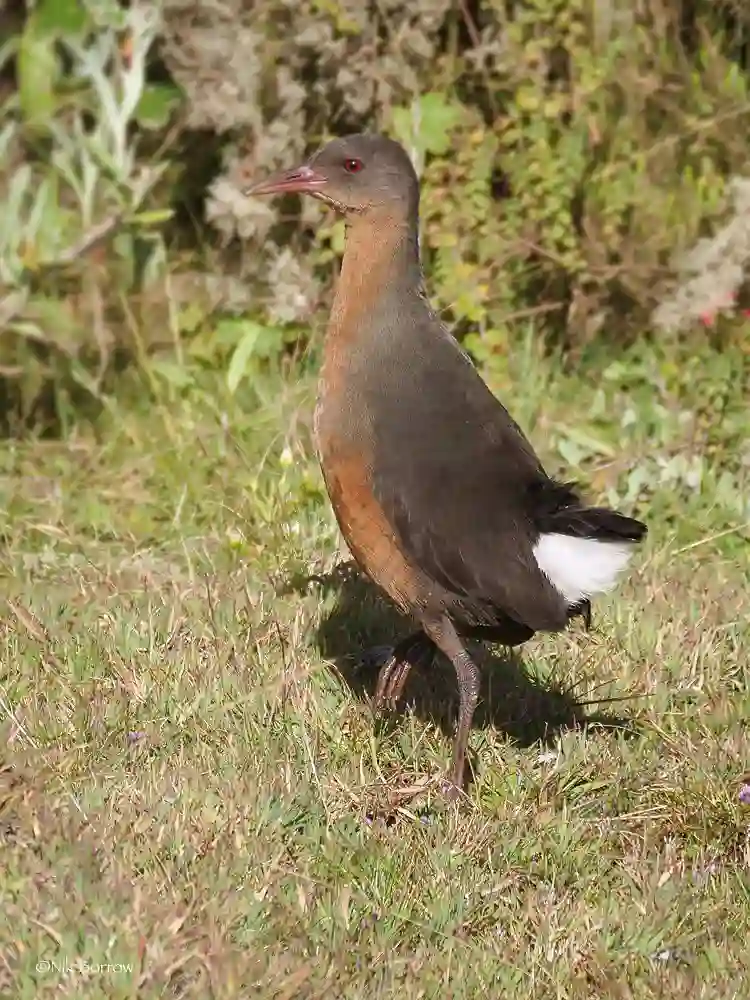
• Scientific name: Rougetius rougetii The Rouget's Rail, also known by its scientific name Rougetius rougetii, is a species of bird that belongs to the family Rallidae. It is the only member of the genus Rougetius and is found in Eritrea and Ethiopia. Its natural habitats include subtropical or tropical high-altitude shrubland, grassland, rivers, swamps, freshwater marshes, pastureland, rural gardens, and urban areas. However, it is threatened by habitat loss. The Rouget's Rail lays eggs between March and October and nests on wet ground, among rushes or in rushes over water, or in grass tussocks. The nest is a cushion or a shallow cup-shaped structure made with dead rushes or grass, and the female lays 4-8 oval, creamy-white to white eggs with a buff wash and darker fine markings. The incubation is mainly performed by the female, but the male probably helps. The chicks are fed by both parents, but the young remain in a family group until they are fully grown. The Rouget's Rail is widespread in Ethiopia but much less common in Eritrea. It is confined to highlands in both regions and is affected by degradation of the habitat caused by intensive grazing in wet pastures, making these areas unsuitable for the rails that need vegetation. Grasslands are converted to cultivated fields, and the species is also vulnerable to droughts. Destruction and modification of the habitat are the major threats to this species. The population is estimated at less than 10,000 individuals, roughly rounded to 1,500/7,000 mature individuals, and this population is declining. Therefore, the Rouget's Rail is currently listed as Near Threatened. The bird is about 30 cm long, with unstreaked olive-brown upperparts and cinnamon-rufous underparts. The lower flanks are dark olive-brown, and the chin is whitish. The eyes are reddish-chestnut, the bill is reddish, and the legs and feet are purplish-red.
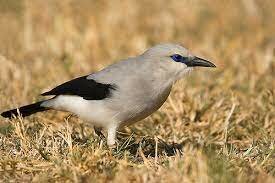
• Scientific name: Zavattariornis stresemanni The Stresemann's bushcrow is a bluish-grey bird, slightly larger than the North American blue jay, with creamy-white throat and chest, and glossy black tail and wings. The iris is brown and the eye is surrounded by a band of naked bright blue skin. The bill, legs, and feet are black. The species is restricted to thorn acacia country in southern Ethiopia near Yavello (Javello), Mega, and Arero. It requires a "bubble" of lower temperature for proper foraging, which is only present within its small range, making it extremely vulnerable to climate change. The bird takes mainly insects, larvae, and pupae, especially of Coeloptera moths. The species feeds in small groups, nests high in an acacia tree, and lays five to six cream eggs with lilac blotches. It is very vocal, particularly when foraging. The population is declining rapidly, and it is considered one of the most threatened birds by climate change. The IUCN Red List of Threatened Species lists the Stresemann's bushcrow as endangered, with fewer than 10,000 birds remaining, and its population is declining rapidly. Interesting Fact: The Stresemann's bushcrow is one of the few warm-blooded animals whose survival is wholly dependent on temperature, making it extremely vulnerable.